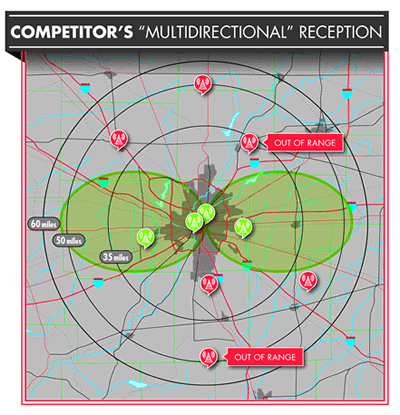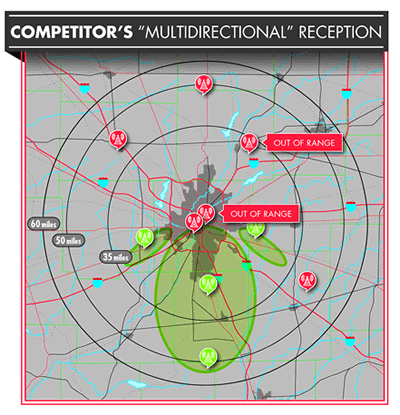FAQ & Troubleshooting
Feel free to browse our FAQ & Troubleshooting guide below.
If you still don't find what you are looking for please check out our Digital Reception Tips page or feel free to use our Ask the Engineer section to have one of our highly trained RCA Antenna Technicians help you with resolving meeting your need.
It depends on your situation; factors determining what type of antenna depend on the distance and direction from the TV station transmitters to your home. Other factors include the transmitter's power and tower height and any obstacles (hills, buildings, etc..) between the tower and your antenna. To help mitigate these factors we offer indoor/outdoor and multi-directional antennas to fit your situation. To help you figure out what best fits your need use our Antenna Finder located on our homepage.
Good question, answer depends on your situation. The main factors determining reception are the distance and direction from the TV station transmitters to your home. Other factors include the transmitter's power and tower height and any obstacles (hills, buildings, etc..) between the tower and your antenna. If you live within a few miles of the transmitter, and the signal path is relatively unobstructed, you may be able to get adequate reception using an indoor antenna. But as you move farther away, getting usable signal strength becomes trickier. This is where careful antenna selection and installation become essential. General rule of thumb, the larger an antenna's surface area is, the greater the signal it will provide. Outdoor antennas typically are larger in size and provide greater access to unobstructed signals potentially blocked by walls, furniture, people, etc? so they tend to outperform indoor antennas. However not everybody has the ability to install or hook up to a roof-top or attic mounted outdoor antenna. Indoor antennas provide a nice alternative as they are generally small, designed to be placed on or near your TV and can work just as well in certain situations. Indoor antennas can also be amplified to boost signal to enhance performance. Refer to our antenna finder in the top left corner of this page to help you in find the right antenna for your situation.
One way to help antennas overcome size or height disadvantages, or otherwise enhance signal gain, is through the use of an amplifier. The amplifier can be built in as it is in many indoor antennas, or it can be a separate device that installs in-line between the antenna and TV. An amplifier that installs on an outdoor antenna or mast is often called a preamplifier or "preamp." RCA also has innovated the amplification process in antennas with SmartBoost™ technology. SmartBoost™ offers precise amplification that allows TV tuners to pick up and amplify the right TV signals, unlike competitors amplifiers that also amplify background broadcast noise.
A passive antenna has no active amplifier parts, it is just an antenna. An active antenna includes a preamplifer or amplifier to increase the gain of the antenna, but it can also refer to an electronic means to tune or match the antenna.
Compared to roof-mounting, installing an antenna in your home's attic has several appealing advantages: installation is much easier, the antenna is hidden from view, and the antenna and connections are not directly exposed to harsh weather. Attic-mounting can be an effective option in areas where strong signals are present. The main disadvantage of attic-mounting is poorer reception, the roof and its materials can reduce signal strength by as much as 50%. In addition other materials may interfere or block signal such metal roof, aluminum siding, metal gutters, or foil-backed insulation in your walls or under the roof. To maintain adequate signal strength, an amplifier or preamp is often used. If that happens, try installing the antenna in a different location. For the best reliability and performance, mount the antenna to a mast and don't let the antenna touch the attic floor.
Yes you can use a signal splitter, however every time you split the signal you are dividing or diluting the signal strength. If you use a 2 way splitter, you will divide the signal in half that will go to each TV set. A four way splitter will divide by four so each TV set will only get a fourth of the signal. If your signals are weak when they are received, you don't want to split it. You usually don't use a splitter with an indoor digital flat antenna. If you have an attic mounted antenna or an outdoor antenna you can split them, but if there is a weak signal channel you may lose it. One solution is to use an amplified splitter or distribution amp, they usually have enough gain to overcome the loss.
Typically the higher the antenna, the better. The fewer obstacles between the antenna and the tower, the better chance you will have of finding a strong signal. Finding TV signal is similar to cell phone coverage. Sometimes walking a few feet in one direction will make a difference between getting signal and no signal. After connecting the coax cable from the antenna to the "Antenna In" port on the TV, run a channel scan. Then flip through the various channels noting signal quality. Now try the antenna in a different location run a channel scan. Each time you move the antenna make note of the number of channels you get and signal strength of your favorite channels.
Yes over-the-air signals are FREE, of course you'll need an antenna but that reception is FREE. Local digital TV broadcasts are everywhere: Although the widest selection of digital TV broadcasts are found in large metropolitan TV markets, over 99% of U.S. TV households have access to at least one local digital station; 89% can get five or more stations. Access to all your local channels: Bandwidth limitations also mean that cable and satellite providers may not carry all the local channels in your area, or may not offer them in high definition. Also, contract disagreements between local cable operators and local broadcasters can mean that major networks may not be available via cable TV in your area.
Good question, TV signal transmission is considered to be "line of sight." First step is to locate the transmitters for your local stations, specifically their direction and distance from your home. To help find these answers use our Antenna Finder in the top left corner of this page. In addition there are a couple good resources to help you in this quest, simply plug in your zip code or address on either Antennaweb.org & TVFool.com
Off-air antenna reception is the best way to enjoy best picture quality of HDTV programs at the full resolution the TV networks intended. Cable and satellite providers offer lots of channels, but to do this they use data compression or other techniques that compromise picture quality, resulting in a "soft" image, distracting video "artifacts" (distortion), or both. Off air antenna pick up and use uncompressed signals directly from the broadcaster allowing you to receive the highest quality signal. See our Signal Quality page located here.
Our antennas receive both high VHF and UHF digital TV broadcast signals. This is important to look for in an antenna because not all antennas are able to receive both frequencies.
Omni-directional means the antenna will receive equally well from all directions. This is important because not all broadcasters are in the same location. You don't want to keep moving the antenna around and adjusting it to receive the different TV channels. A lot of lower quality indoor TV antennas are based on a dipole or loop design and have reception patterns that are restricted bi-directional. This will likely create a problem in that you will have to constantly adjust the antenna to receive certain broadcast signals in your area. Please reference the below graphics that illustrate this point.

